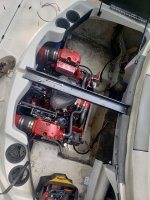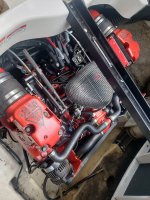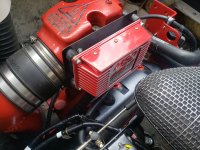BioChemLab
Cadet
- Joined
- Jun 14, 2021
- Messages
- 12
Hey guys.
I'm a year-long lurker, first time poster - you guys have been absolutely invaluable in diagnosing and rebuilding my boat engine over the last few months. Almost everything I couldn't find in the Mercury manuals I downloaded I found answered at least once here. Love this place.
Anyway - my wife's family bought this boat new in 2009. From 2009 to 2018-19 they basically put fuel in it, and nothing else. Yearly the drain plugs were removed from the cooling system but the system was never flushed, and I honestly don't even think they had an oil change done. The belt, the plugs, the oil filter, etc were all factory Mercruiser when I took possession of the boat - and it was stored at a lake house. The trailer hadn't even been used in at least five years, so my suspicion is it was literally NEVER serviced. Last year when they tried to start it to use it it had obviously blown a head gasket, at least one riser, both exhaust manifolds, and several other parts. It was puking oil out of the RTV in the valley, but at least they also hadn't actually replaced the oil that was now caked all on the inside of the engine bay. Another thing I was extremely surprised by was the slapdash nature of the original install on this engine at the factory - they didn't put proper connectors on most of the wires (just heat-shrink crimped most of them) and there were three terminated connections just hanging out, unshielded, on the intake manifold. I get that those wires might not be used on this specific model but Jesus Christ. Shove them in the loom with some tape around them or something!
Anyway - I'm a long-time automotive mechanic, but my specialty has been in Asian and European cars - I'm fully comfortable doing a TT V12 swap on my Merc CL600 but stabbing the distributor in this damn 4.3 was giving me sweaty hands. After probably 3 weeks of running into every single problem I could possibly run into, the boat finally runs and runs well. I've learned more than I ever thought I would know about timing and ignition on American-designed V-engines, and I'm extremely happy with the wealth of knowledge I've accumulated on my engine. We had our maiden voyage with the new engine last weekend and had some overheating problems - which I'm assuming is the impeller/water pump blockage in the outdrive (yet another thing that has never, ever been replaced.) I'm doing that tomorrow, and will be going back out for a proper maiden voyage this weekend. The engine runs great - starts like EFI at the touch of the key, and no more run-on after you shut the key off. I'm still under 3 hours total runtime on the brand new engine so I haven't done any full-throttle starts yet, but it definitely seems to be significantly more responsive than it used to be.
The main point of my post is to find out anything else I might have stupidly overlooked - I didn't even think about the air cleaner/flame arrestor thing, and we were driving around on the lake with the pictured filter for a few hours. I never smelt excessive fuel odors in the engine bay (and I had it open multiple times to check for leaks and such) so while it was stupid, I don't think it was necessarily dangerous. I've already ordered a K&N flame arrestor that will fit the new carb on the engine, and I'm now nervous that I made another boneheaded move or three while building the engine. My inherent lack of understanding about this engine had me attempting to time the damn thing on #6 post on the distributor before I actually read the MERCRUISER manual and found the difference between a crossfire cap and a standard dist. cap, and I wanted to run my build past some people who know more than I.
The new block was from a 2002 Chevrolet Blazer (different casting number than my original block, but the same otherwise except for having to use the plastic timing cover.)
Heads are brand new castings with stainless valves and seats, and I used the appropriate "marine" head gasket kit with the composite head gaskets, not MLS.
The crank, pistons, rods, and cam are all out of the original engine as my machine shop said they were in perfect shape, and I know the cam in a marine engine is different from standard 4.3. The block was hot tanked and cleaned, oil passages cleaned, aligned and bored, and such and all new bearings, bolts, and gaskets installed throughout. I followed the Mercruiser manual when assembling the engine, so I used aircraft sealant on all the spots it said to use Quicksilver sealant, etc etc. I just flipped back to the automotive manual when I was stabbing the distributor because I was hot and stupid.
I used an Edelbrock Performer intake manifold (because I'm stupid and I didn't see they offered a "Marine" version...) and an Edelbrock 1409 600cfm Marine rated carb with an electric choke.
After futzing around with the stock amplifier setup like an idiot I realized my amplifier module was bad, and didn't want to **** with spending weeks and $650 to get a new one so I pulled all that **** out and used an MSD 6AL-2 which can trigger from the factory hall effect sensor in the distributor. I then replaced the distributor sensor with a new quicksilver part as apparently they are doomed after 15-ish years, and mine was 12 years old at that point. I realize that the 6AL-2 isn't marine rated and that they do offer a 6AL marine edition, but the marine edition can't trigger from a hall-effect directly, so I'd either need to wire in a GM amplifier or replace the factory one anyway. I could also replace the distributor with an HEI model but that is just another part to buy. I also read that since the marine ones are potted completely, they offer zero rebuild options on them, compared to a roughly $70 rebuild for the 6AL-2. Not to mention multiple reports from people who have direct experience using a standard automotive 6AL on their freshwater boats for years with no ill effects - and worst-case scenario if it quits, I can pick one up local the same day and be back on the water. I just have to lie to MSD about it being in a boat to get it rebuilt which, while normally I'd take issue with that, it's not a warranty rebuild - I'm paying for it. I also refuse to believe that the closed engine bay in my freshwater ski boat will get any extra water exposure than underneath the hood of my non-closed race car (which half the time I drive with the hood off anyway, since it's in a perpetual quantum state of being both broken and working the best it ever has.)
Anyway, my long intro is over. I've attached some pictures of my install so far, and I'm interested to see the opinions of people who know the difference between "working" and "correct", and to see if there's anything stupid that I have overlooked. I know the engine bay is still filthy as **** - standard engine degreaser didn't really seem to touch it, but I'm going to drag out the pressure washer after I finish the outdrive rebuild and make it nice and sparkly.
For those that are interested, the engine runs great. I did my first oil change (on the water, actually... at anchor...) at exactly 1 hour into running, and it is still nice and clean with minimal shiny sparkles. Since it looks so good I'm probably just going to change the filter again halfway through the day this weekend. Might snag a few quarts out of the suction drain while I do so to make sure there isn't anything glittery in there, but if not I'll probably just whack it back in to round out the day. While I'm not 100% happy with relying on the MSD box for ignition and there are plenty of people who claim they are unreliable, this boat is ultimately a pleasurecraft. And while it would suck to have to drive to the parts store and spend $300 on a new unit, I could effectively plug it in in about ten minutes and be right back to boating. If it turns out it's a pile of ****, there are better-hardened units that do the same thing I could look at purchasing if it ends up being a mistake.
Thanks in advance
Jonathan
I'm a year-long lurker, first time poster - you guys have been absolutely invaluable in diagnosing and rebuilding my boat engine over the last few months. Almost everything I couldn't find in the Mercury manuals I downloaded I found answered at least once here. Love this place.
Anyway - my wife's family bought this boat new in 2009. From 2009 to 2018-19 they basically put fuel in it, and nothing else. Yearly the drain plugs were removed from the cooling system but the system was never flushed, and I honestly don't even think they had an oil change done. The belt, the plugs, the oil filter, etc were all factory Mercruiser when I took possession of the boat - and it was stored at a lake house. The trailer hadn't even been used in at least five years, so my suspicion is it was literally NEVER serviced. Last year when they tried to start it to use it it had obviously blown a head gasket, at least one riser, both exhaust manifolds, and several other parts. It was puking oil out of the RTV in the valley, but at least they also hadn't actually replaced the oil that was now caked all on the inside of the engine bay. Another thing I was extremely surprised by was the slapdash nature of the original install on this engine at the factory - they didn't put proper connectors on most of the wires (just heat-shrink crimped most of them) and there were three terminated connections just hanging out, unshielded, on the intake manifold. I get that those wires might not be used on this specific model but Jesus Christ. Shove them in the loom with some tape around them or something!
Anyway - I'm a long-time automotive mechanic, but my specialty has been in Asian and European cars - I'm fully comfortable doing a TT V12 swap on my Merc CL600 but stabbing the distributor in this damn 4.3 was giving me sweaty hands. After probably 3 weeks of running into every single problem I could possibly run into, the boat finally runs and runs well. I've learned more than I ever thought I would know about timing and ignition on American-designed V-engines, and I'm extremely happy with the wealth of knowledge I've accumulated on my engine. We had our maiden voyage with the new engine last weekend and had some overheating problems - which I'm assuming is the impeller/water pump blockage in the outdrive (yet another thing that has never, ever been replaced.) I'm doing that tomorrow, and will be going back out for a proper maiden voyage this weekend. The engine runs great - starts like EFI at the touch of the key, and no more run-on after you shut the key off. I'm still under 3 hours total runtime on the brand new engine so I haven't done any full-throttle starts yet, but it definitely seems to be significantly more responsive than it used to be.
The main point of my post is to find out anything else I might have stupidly overlooked - I didn't even think about the air cleaner/flame arrestor thing, and we were driving around on the lake with the pictured filter for a few hours. I never smelt excessive fuel odors in the engine bay (and I had it open multiple times to check for leaks and such) so while it was stupid, I don't think it was necessarily dangerous. I've already ordered a K&N flame arrestor that will fit the new carb on the engine, and I'm now nervous that I made another boneheaded move or three while building the engine. My inherent lack of understanding about this engine had me attempting to time the damn thing on #6 post on the distributor before I actually read the MERCRUISER manual and found the difference between a crossfire cap and a standard dist. cap, and I wanted to run my build past some people who know more than I.
The new block was from a 2002 Chevrolet Blazer (different casting number than my original block, but the same otherwise except for having to use the plastic timing cover.)
Heads are brand new castings with stainless valves and seats, and I used the appropriate "marine" head gasket kit with the composite head gaskets, not MLS.
The crank, pistons, rods, and cam are all out of the original engine as my machine shop said they were in perfect shape, and I know the cam in a marine engine is different from standard 4.3. The block was hot tanked and cleaned, oil passages cleaned, aligned and bored, and such and all new bearings, bolts, and gaskets installed throughout. I followed the Mercruiser manual when assembling the engine, so I used aircraft sealant on all the spots it said to use Quicksilver sealant, etc etc. I just flipped back to the automotive manual when I was stabbing the distributor because I was hot and stupid.
I used an Edelbrock Performer intake manifold (because I'm stupid and I didn't see they offered a "Marine" version...) and an Edelbrock 1409 600cfm Marine rated carb with an electric choke.
After futzing around with the stock amplifier setup like an idiot I realized my amplifier module was bad, and didn't want to **** with spending weeks and $650 to get a new one so I pulled all that **** out and used an MSD 6AL-2 which can trigger from the factory hall effect sensor in the distributor. I then replaced the distributor sensor with a new quicksilver part as apparently they are doomed after 15-ish years, and mine was 12 years old at that point. I realize that the 6AL-2 isn't marine rated and that they do offer a 6AL marine edition, but the marine edition can't trigger from a hall-effect directly, so I'd either need to wire in a GM amplifier or replace the factory one anyway. I could also replace the distributor with an HEI model but that is just another part to buy. I also read that since the marine ones are potted completely, they offer zero rebuild options on them, compared to a roughly $70 rebuild for the 6AL-2. Not to mention multiple reports from people who have direct experience using a standard automotive 6AL on their freshwater boats for years with no ill effects - and worst-case scenario if it quits, I can pick one up local the same day and be back on the water. I just have to lie to MSD about it being in a boat to get it rebuilt which, while normally I'd take issue with that, it's not a warranty rebuild - I'm paying for it. I also refuse to believe that the closed engine bay in my freshwater ski boat will get any extra water exposure than underneath the hood of my non-closed race car (which half the time I drive with the hood off anyway, since it's in a perpetual quantum state of being both broken and working the best it ever has.)
Anyway, my long intro is over. I've attached some pictures of my install so far, and I'm interested to see the opinions of people who know the difference between "working" and "correct", and to see if there's anything stupid that I have overlooked. I know the engine bay is still filthy as **** - standard engine degreaser didn't really seem to touch it, but I'm going to drag out the pressure washer after I finish the outdrive rebuild and make it nice and sparkly.
For those that are interested, the engine runs great. I did my first oil change (on the water, actually... at anchor...) at exactly 1 hour into running, and it is still nice and clean with minimal shiny sparkles. Since it looks so good I'm probably just going to change the filter again halfway through the day this weekend. Might snag a few quarts out of the suction drain while I do so to make sure there isn't anything glittery in there, but if not I'll probably just whack it back in to round out the day. While I'm not 100% happy with relying on the MSD box for ignition and there are plenty of people who claim they are unreliable, this boat is ultimately a pleasurecraft. And while it would suck to have to drive to the parts store and spend $300 on a new unit, I could effectively plug it in in about ten minutes and be right back to boating. If it turns out it's a pile of ****, there are better-hardened units that do the same thing I could look at purchasing if it ends up being a mistake.
Thanks in advance
Jonathan






















